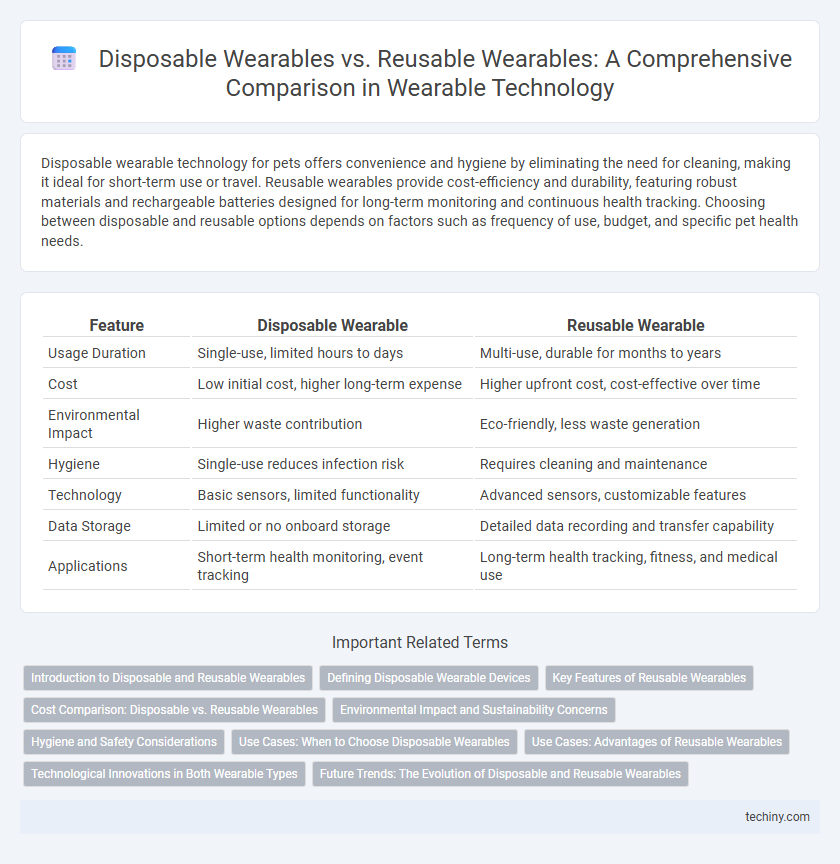Disposable wearable technology for pets offers convenience and hygiene by eliminating the need for cleaning, making it ideal for short-term use or travel. Reusable wearables provide cost-efficiency and durability, featuring robust materials and rechargeable batteries designed for long-term monitoring and continuous health tracking. Choosing between disposable and reusable options depends on factors such as frequency of use, budget, and specific pet health needs.
Table of Comparison
| Feature | Disposable Wearable | Reusable Wearable |
|---|---|---|
| Usage Duration | Single-use, limited hours to days | Multi-use, durable for months to years |
| Cost | Low initial cost, higher long-term expense | Higher upfront cost, cost-effective over time |
| Environmental Impact | Higher waste contribution | Eco-friendly, less waste generation |
| Hygiene | Single-use reduces infection risk | Requires cleaning and maintenance |
| Technology | Basic sensors, limited functionality | Advanced sensors, customizable features |
| Data Storage | Limited or no onboard storage | Detailed data recording and transfer capability |
| Applications | Short-term health monitoring, event tracking | Long-term health tracking, fitness, and medical use |
Introduction to Disposable and Reusable Wearables
Disposable wearables are single-use devices designed for short-term monitoring, often used in healthcare for temporary patient tracking or specific events, emphasizing convenience and hygiene. Reusable wearables, built with durable materials and advanced sensors, support continuous, long-term monitoring and data collection for fitness, health, and industrial applications. Both types leverage embedded technologies such as biosensors, Bluetooth connectivity, and flexible electronics to meet diverse user needs across healthcare, sports, and safety industries.
Defining Disposable Wearable Devices
Disposable wearable devices are single-use electronic gadgets designed for short-term applications such as health monitoring or event access. These devices often feature lightweight materials, limited battery life, and cost-effective production to ensure affordability and ease of disposal. Common examples include fitness trackers for short-term medical studies and event wristbands with RFID capabilities.
Key Features of Reusable Wearables
Reusable wearables feature durable materials and advanced battery systems designed for long-term use, offering enhanced sustainability compared to disposable alternatives. These devices often incorporate sophisticated sensors and modular components for easy maintenance and upgrades, ensuring consistent performance over time. Their higher cost-effectiveness and reduced electronic waste make reusable wearables a preferred choice for continuous health monitoring and industrial applications.
Cost Comparison: Disposable vs. Reusable Wearables
Disposable wearables typically offer a lower upfront cost, making them ideal for short-term use or single events, but their expenses accumulate with frequent replacements. Reusable wearables have a higher initial investment, yet provide long-term cost efficiency through durability and reduced need for continual purchases. Evaluating total lifecycle costs reveals that reusable wearables are more economical for extended use despite the higher starting price.
Environmental Impact and Sustainability Concerns
Disposable wearables generate significant electronic waste due to their short lifespan and limited recyclability, contributing to environmental pollution and resource depletion. Reusable wearables minimize waste by supporting longer usage cycles and incorporating sustainable materials, reducing their carbon footprint and environmental impact. Prioritizing eco-friendly design and circular economy principles enhances sustainability in wearable technology manufacturing and disposal processes.
Hygiene and Safety Considerations
Disposable wearable technology offers enhanced hygiene by minimizing the risk of cross-contamination through single-use designs, making it ideal for medical and high-contact environments. Reusable wearables require rigorous cleaning protocols and antimicrobial materials to maintain safety and prevent pathogen buildup. Prioritizing hygiene in wearable technology depends on the application, balancing convenience with effective sanitation measures for optimal user protection.
Use Cases: When to Choose Disposable Wearables
Disposable wearables are ideal for short-term health monitoring in clinical trials, emergency response situations, and events requiring single-use hygiene controls, such as infection tracking during pandemics. These devices provide cost-effective, lightweight, and hygienic solutions when prolonged use or device maintenance is impractical. Selecting disposable wearables reduces cross-contamination risks and ensures immediate, accurate data collection without the need for device sanitization or battery replacement.
Use Cases: Advantages of Reusable Wearables
Reusable wearables offer significant advantages in healthcare monitoring by providing continuous, long-term data collection without frequent replacements, reducing operational costs compared to disposable counterparts. Their durability supports complex sensors and enhanced battery life, making them ideal for chronic disease management and fitness tracking. Furthermore, reusable devices contribute to environmental sustainability by minimizing electronic waste.
Technological Innovations in Both Wearable Types
Disposable wearable technology incorporates low-cost sensors and flexible materials enabling single-use applications in health monitoring and environmental sensing. Reusable wearables leverage advanced battery technology, durable materials, and adaptive software algorithms for extended use and real-time data analytics. Innovations such as biodegradable electronics in disposables and modular design in reusables expand functionality and sustainability in wearable devices.
Future Trends: The Evolution of Disposable and Reusable Wearables
Emerging trends in wearable technology highlight a shift towards hybrid models that combine the sustainability of reusable wearables with the convenience of disposable designs, leveraging advanced biodegradable materials and embedded sensors. Innovations in energy harvesting and wireless charging are propelling reusable wearables into longer lifecycle applications, while disposable wearables are becoming more cost-effective for short-term health monitoring and event-based uses. Future developments are poised to integrate AI-driven analytics and personalized data management, optimizing user experience across both disposable and reusable wearable devices.
Disposable Wearable vs Reusable Wearable Infographic

 techiny.com
techiny.com